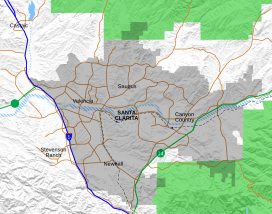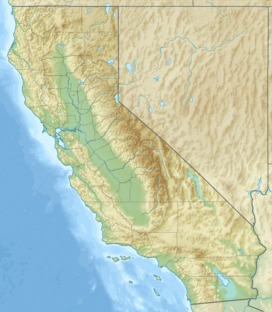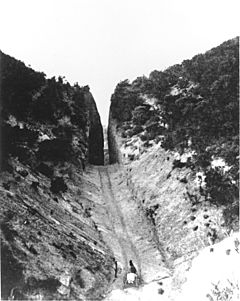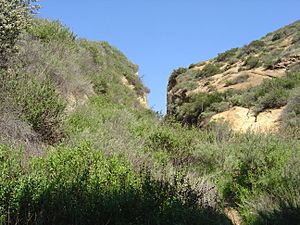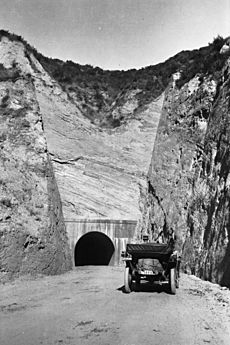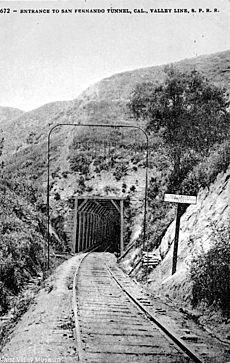Newhall Pass facts for kids
Quick facts for kids Newhall Pass |
|
|---|---|
| San Fernando Pass, Fremont Pass, Beale's Cut | |
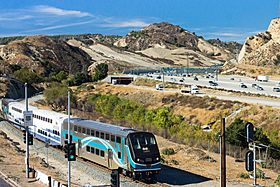 |
|
| Elevation | 1,755 ft (535 m) |
| Traversed by | |
| Location | Los Angeles County, California |
| Range | Santa Susana Mountains/San Gabriel Mountains |
| Coordinates | 34°20′45″N 118°30′36″W / 34.3458°N 118.5101°W |
| Topo map | Oat Mountain, CA |
Newhall Pass is a low mountain pass in Los Angeles County, California. It was once called Fremont Pass and San Fernando Pass. It also includes a famous part known as Beale's Cut. This pass separates the Santa Susana Mountains from the San Gabriel Mountains.
An explorer named Gaspar de Portolá visited the pass in August 1769. Later, it was named after Henry Newhall, an important businessman from the 1800s.
Newhall Pass connects the San Fernando Valley to the Santa Clarita Valley. It is a main entrance to the larger Greater Los Angeles Area. The pass is well-known for its huge road interchange and the old San Fernando Tunnel.
The weather in the pass can change a lot. Summers can be very hot, while winters can sometimes drop below freezing. Snow is rare from December to February. When it does snow, it can cause heavy traffic and accidents. The pass can also flood a lot during La Niña and El Niño weather events. Wildfires have also sometimes closed the pass and California State Route 14.
Contents
History of Newhall Pass
Newhall Pass was first called 'Fremont Pass'. This name came from General John C. Frémont. People thought he traveled through it in 1847. He was on his way to sign the Treaty of Cahuenga. However, he actually went a little east of the pass on a different path called the El Camino Viejo.
Lyons Station: An Old Stop
In 1853, a businessman from Los Angeles named Henry Clay Wiley set up a windlass (a machine for lifting heavy things) at Fremont Pass. This helped wagons go up and down the steep Santa Clara Divide more easily. He also built a tavern, a hotel, and a stable nearby.
In 1854, Wiley sold his business to Sanford and Cyrus Lyon. The place then became known as Lyons Station. Around the same time, Phineas Banning started supplying goods to Fort Tejon.
Beale's Cut: A Famous Road Cut
The steep pass was made easier to cross with a deep, slot-like road cut. Charles H. Brindley, Andrés Pico, and James R. Vineyard created this cut. The State of California gave them a 20-year contract to keep the road in good shape and collect tolls.
This cut helped travelers get through the "San Fernando Mountain." This mountain was the hardest part of the Fort Tejon Road. This road was the main way to travel inland from Los Angeles to the north. The Butterfield Overland Mail, a stagecoach service that carried mail, started using this direct route.
In 1861, Edward Fitzgerald Beale became the federal Surveyor General of California and Nevada. In 1863, Beale was given the right to collect tolls in the pass. Beale kept these rights for the next 20 years. Because of this, the cut became known as "Beale's Cut."
Beale's Cut was eventually made 90 feet (27 meters) deep. It was used for travel until the Newhall Tunnel was finished in 1910.
Beale's Cut appeared in many old silent western movies. Movie directors like John Ford and D. W. Griffith loved to film there. In Ford's 1923 movie Three Jumps Ahead, cowboy star Tom Mix is shown jumping over the pass. People still debate if Mix himself made the jump or if a stuntman did it. John Ford used this location in at least four films over 20 years.
Beale's Cut still exists today, but cars cannot drive through it. Part of it collapsed during the Northridge Earthquake on January 17, 1994. Now it is about 30 feet (9 meters) deep.
You can see it from the Sierra Highway. It is about one mile north of where The Old Road and Sierra Highway meet. It is just after the first bridge under State Route 14. Beale's Cut is between Sierra Highway and the new freeway. It is about a quarter mile northeast of a stone marker. It is hard to find today because it is fenced off and not very close to Sierra Highway.
Newhall Pass: The Modern Route
In 1910, the 435-foot (133-meter) Newhall Auto Tunnel was built. It was a quarter-mile northwest of Beale's Cut. However, the tunnel was only 17.5 feet (5.3 meters) wide. This made two-way traffic very slow.
The California Division of Highways decided to replace the tunnel. In July 1938, work began to remove the rock above the tunnel. This created a four-lane highway. This road was first called Highway 6, then Highway 14, and now it is the Sierra Highway. The cut for the tunnel is west of today's Highway 14. It is east of Gates King Open Space.
The pass is named after local businessman Henry Newhall. His land became the basis for the city of Santa Clarita. Newhall came to California in 1850 during the California Gold Rush. Over time, he bought many properties. The most important was the 46,460-acre (188 square kilometers) Rancho San Francisco. This was in northern Los Angeles County.
He allowed the Southern Pacific Railroad to build tracks through what is now Newhall Pass. He also sold them land where they built a town. They named the town Newhall after him. The first train station on the line was named Saugus, after his hometown. After he died in 1882, his family started the Newhall Land and Farming Company.
Newhall Pass is still a very important traffic route today. The Newhall Pass interchange connects Interstate 5 (Golden State Freeway) and State Route 14 (Antelope Valley Freeway). Sierra Highway, Foothill Boulevard, and San Fernando Road also go through the pass. The Sierra Highway crossing was once the Newhall Tunnel. Los Angeles County built it in 1910 to replace Beale's Cut.
San Fernando Tunnel: A Railroad Path
Metrolink's Antelope Valley Line and the Union Pacific Railroad (which used to be the Southern Pacific Transportation Company) go through the pass. They use the San Fernando Tunnel. This railroad tunnel is 6,940 feet (2,115 meters) long. It took a year and a half to build.
Over 1,500 mostly Chinese workers built the tunnel. Construction started at the south end of the mountain on March 22, 1875. Many of these workers had already helped build Southern Pacific's tunnels in the Tehachapi Pass. The mountain was made of sandstone mixed with water and oil. This caused frequent cave-ins. Workers had to constantly support the tunnel with timbers as they dug.
The first planned location for the north end of the tunnel was near Lyons Station Stagecoach Stop. But this spot had too many cave-ins because of oil-soaked rock. So, the north end was moved a bit further west, closer to the town of Newhall, California. Digging from the north end started in June 1875.
Water was a big problem during construction. Pumps were used to keep the tunnel from flooding. Workers digging from both the north and south ends met on July 14, 1876. The two parts of the tunnel were only half an inch out of line! The tunnel was 22 feet (6.7 meters) high. It was 16.5 feet (5 meters) wide at the bottom and over 18 feet (5.5 meters) wide at the shoulders.
Tracks were laid inside the tunnel as it was being dug. Horse-pulled cars used these tracks to remove dirt and rock. The first train went through the tunnel on August 12, 1876. On September 4, Charles Crocker told Southern Pacific that the railroad track between San Francisco and Los Angeles was complete.


